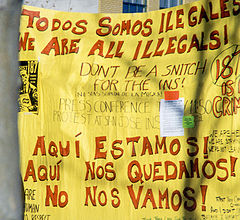Chicano

Chicano is a name given to Mexicans and their descendants ( Mexican Americans ) living in the United States . They belong to the group of Hispanics or Latinos .
The term Chicano, originally used in a discriminatory way, is relatively new and is now used by Mexican immigrants to denote their special life situation. The word probably originated around 1930 and the following 1940s, when, as a result of an agreement between the governments of the two countries, poor Mexican farm laborers were used as cheap labor in the United States with the help of the bracero program.
The use of the word can probably first be proven in the fields in California . The corruption of the workers' own designation as “Mexicanos” is to be seen in connection with regional peculiarities in the pronunciation of the immigrants: The “x” is pronounced as a sibilant, located between “sch” and “ch”, so it sounds something like “Me- chi-ka-noss ". As a swear word shortened to “Chicanos” in the English adaptation, it was picked up by Mexican activists in the civil rights movement in the 1960s and 1970s in order to confidently emphasize an independent Mexican-American cultural identity.
Political movement
The name was taken up and became the fighting term for an independent political movement that represents the interests of the large population group with many places and numerous subgroups. Oppositional political activities also have a negative connotation for those who try to adapt to the American way of life as smoothly as possible .
Chicano press
The Chicano press is an important component of the movement and has done a lot in spreading the story, literature and news. The press created a link between the core group and the periphery, conveying a national Chicano identity and community. The Chicano Press Association (CPA), founded in 1969, made a significant contribution to the development of this national ethos. The CPA argued that an active press was essential for the liberation of the Chicano and was the mouthpiece for about twenty newspapers, mainly in California but also throughout the Southwest.
Chicanos in many colleges began publishing their own student newspapers in the 1968's. However, many of them stopped their publication within a year, or merged with larger publications. Organizations like the Brown Berets and MECHA also started their own independent newspapers. And Chicano communities started magazines like El Grito del Norte in Denver and Caracol in San Antonio .
More than 300 newspapers and magazines are associated with the movement.
Chicano literature
As Chicanoliteratur (in English. Chicano literature) the whole narrative or lyrical works is understood, caused by authors who see themselves as members of the Chicanogemeinschaft. The main authors include Rudolfo Anaya , Américo Paredes , Rodolfo Gonzales , Rafael C. Castillo , Julian S. Garcia , Gary Soto , Oscar Zeta Acosta , Luis Valdez , John Rechy , Luis Omar Salinas , Tino Villanueva , Denise Chavez , Daniel Olivas , Benjamin Alire Sáenz , Tomás Rivera , Luis Alberto Urrea , Lorna Dee Cervantes , Sergio Troncoso , Rigoberto González , Rolando Hinojosa and Alicia Gaspar de Alba .
Chican a literature is part of the Chican o literature, which particularly highlights the experiences of female members of the Chicano communities. María Ruiz de Burton was the first Mexican-American author to publish in English in 1872. The literary critic Claudia Sadowski-Smith has described the author Sandra Cisneros as probably the best-known Chicana writer and as the first Mexican-American author to be published by one of the major American publishing houses to grant her a pioneering role. Cisnero's first novel Das Haus in Mango Straße was first published in 1989 by the small publishing house Arte Público Press In 1989, whose publishing program was geared towards a reading audience with Latin American roots. The second edition, however, was published in 1991 by Vintage Books, a publisher within the Random House group. In 1991, Woman Hollering Creek was published direct by Random House. As Cisneros' biographer Ganz notes, up to this point it was only male Chicano authors who had successfully switched to one of the major publishers. The fact that Cisnero's first novel attracted so much attention that a publisher such as Vintage Books took it on shows the growing importance of Chicano literature within the American literary scene.
In an interview on National Public Radio , Cisneros said on September 19, 1991.
“I don't think I can be happy if I'm the only one published by Random House when there are so many great writers - both Latinos and Latinas or Chicanos and Chicanas - who are not great in the US Publishing houses are published or are not even known to them. If my success meant that the publishers would take a second look at these writers - and then publish them in large numbers, then we will finally arrive in this country. "
Chicano Cinema
Under Chicano Cinema (dt. Chicanokino) refers to the totality of the cinematographic production by a director who sees himself as a member of Chicanogemeinschaft. The resulting films trace the history of ideas of the Chicano movement, reflected in the medium of film. This can be understood as a continuum that moves from a pole of resistance and isolation towards increased assimilation and rapprochement with Anglo-American culture. The last phase is increasingly accompanied by criticism from those in favor of cultural independence. The described change can be observed both on the basis of the thematic as well as the film aesthetic development of the Chicano Cinema over the years, in the form of a shift towards the tried and tested strategies or optics of Hollywood cinema.
Chicano art
Art in the Chicano movement was marked by a sprouting and increased political commitment, as well as an energization through cultural pride. The actual Chicano species developed in the 1960s. In the initial phase, this art style was characterized by publicly accessible forms of expression. Chicano artists created a bi-cultural style with American and Mexican influences. The Mexican style is expressed through bright colors and expressionistic elements. Prominent examples of Chicano Muralism in California are the historic Estrada Courts Housing Projects in Boyle Heights , or La Marcha Por La Humanidad , at the University of Houston . Since the late 1960s, Chicano, Mexican-American and Hispanic cultural centers, theaters, film festivals, museums, galleries and organizations have sprung up in many places.
About 20 years later, the Chicano artists were changed by political priorities and social values, but also better recognized in society. There was a demand for her art and working for museums and collectors led to new forms of work such as easel works. In the 1970s, women in particular became famous as artists and individualism also increased as many Chicano artists became successful on the art market. In addition to artists like Carlos Almaraz, numerous graffiti & custom artists shape the Chicano art scene today, which can also be found in the numerous subcultures such as the lowrider & custom bike community. In vehicle refinement, bright colors (brightly colored flake paints) and extremely lowered vehicles in a classic look are very popular style elements of Chicano art.
Examples of this development
- Political resistance and the search for one's own aesthetic:
I am Joaquín. Dir. Luis Valdez. Script Rodolfo Gonzalez. 1969.
- Connection to the Hollywood formula:
La Bamba. Dir. Luis Valdez. Perfs. Lou Diamond Phillips, Esai Morales. Columbia Pictures, 1983.
Chicano skirt
Chicano rock is a stylistically open form of rock music that has been played by the Mexican population of the United States of America since the mid-1950s. The ethnic origin of the musicians is the main unifying characteristic of the performers who belong to Chicano Rock. The regional focus of the scene is the greater Los Angeles area with a concentration in the city's East Side. In terms of time, Chicano Rock has several high points, which are stylistically influenced by the neighboring music trends of the respective decade. Prominent representatives of Chicano Rock are Richie Valens , Linda Ronstadt , Carlos Santana and Los Lobos .
El Vez , the self-proclaimed "Mexican Elvis", interprets a humorous-satirical form of Chicano Rock . In his often socially critical rewrapping of Elvis classics and other rock songs, he clearly shows his cultural background.
literature
- Gloria Anzaldúa (1987): Borderlands: The New Mestiza = La Frontera , San Francisco: Spinsters / Aunt Lute, ISBN 978-0-933216-25-9 .
- Noriega, Chon A., Shot in America: Television, the State, and the rise of Chicano Cinema, University of Minnesota Press, Minneapolis and London 2002.
- That. (ed.), Chicanos and Film: Essays on Chicano Representation and Resistance, Garland Publishing Inc., New York & London 1992.
- Jacqueline Doyle (1994): More Room of Her Own: Sandra Cisneros's The House on Mango Street , MELUS (The Society for the Study of the Multi-Ethnic Literature of the United States (MELUS)) 19 (4): 5-35, doi : 10.2307 / 468200 .
- Francisco A. Rosales, Arturo Rosales (eds.): Chicano !: The History of the Mexican American Civil Rights Movement ; Arte Publico Press, March 1996
- Francisco A. Rosales, F. Arturo Rosales: Testimonio: A Documentary History of the Mexican-American Struggle for Civil Rights. Hispanic Civil Rights; Arte Publico Press, 2000
- Robin Ganz (1994): Sandra Cisneros: Border Crossings and Beyond , MELUS (The Society for the Study of the Multi-Ethnic Literature of the United States) 19 (1): 19-29, doi : 10.2307 / 467785 .
- Alma Garcia, Mario Garcia: Chicana Feminist Thought: The Basic Historical Writings ; Routledge, 1997
- Carla Trujillo (ed.): Living Chicana theory ; Berkeley, Calif .: Third Woman Press, 1998
- Chon A. Noriega: Shot in America: Television, the State, and the Rise of Chicano Cinema ; University of Minnesota Press, 2000
- Claudia Sadowski-Smith (2008): Border Fictions: Globalization, Empire, and Writing at the Boundaries of the United States . Charlottesville, University of Virginia Press 2008, ISBN 978-0-8139-2689-6 .
- Aztlán: A Journal of Chicano Studies online resource
- David Reyes, Tom Waldman: Land of a Thousand Dances. Chicano Rock 'n' Roll from Southern California . 1st edition. University of New Mexico Press, Albuquerque 1998, ISBN 0-8263-1883-5 (American English).
- Steven Loza: Barrio Rhythm. Mexican American Music in Los Angeles . University of Illinois Press, Urbana, Chicago 1993, ISBN 0-252-06288-4 (American English).
Web links
Single receipts
- ^ Chicano / Latino Movements History and Geography .
- ↑ Chicano Newspapers and Periodicals, 1966-1979 .
- ^ Claudia Sadowski-Smith (2008): Border Fictions: Globalization, Empire, and Writing at the Boundaries of the United States . Charlottesville, University of Virginia Press 2008, ISBN 978-0-8139-2689-6 . P. 33.
- ^ Robin Ganz (1994): Sandra Cisneros: Border Crossings and Beyond , MELUS (The Society for the Study of the Multi-Ethnic Literature of the United States) 19 (1): 19-29, doi : 10.2307 / 467785 p. 27 .
- ↑ Interview with Tom Vitale on National Public Radio, quoted in: Robin Ganz (1994): Sandra Cisneros: Border Crossings and Beyond , MELUS (The Society for the Study of the Multi-Ethnic Literature of the United States) 19 (1): 19-29, doi : 10.2307 / 467785 , p. 27
- ^ Shifra M. Goldman: Latin American artists of the USA . Oxford Art Online. Retrieved April 20, 2012.
- ^ Estrada Courts .
- ↑ https://www.thunderbike.de/model/chicano/
